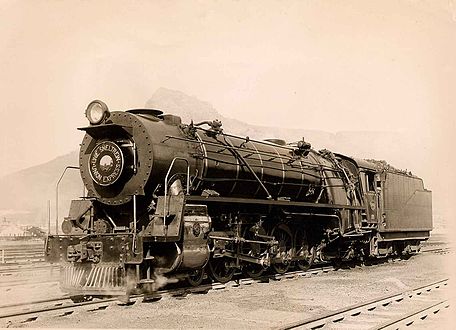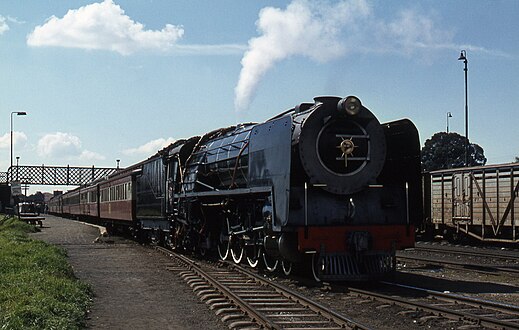South African Class 15E 4-8-2
| South African Class 15E 4-8-2 | |||||||||||||||||||||||||||||||||||||||||||||||||||||||||||||||||||||||||||||||||||||||||||||||||||||||||||||||||||||||||||||
|---|---|---|---|---|---|---|---|---|---|---|---|---|---|---|---|---|---|---|---|---|---|---|---|---|---|---|---|---|---|---|---|---|---|---|---|---|---|---|---|---|---|---|---|---|---|---|---|---|---|---|---|---|---|---|---|---|---|---|---|---|---|---|---|---|---|---|---|---|---|---|---|---|---|---|---|---|---|---|---|---|---|---|---|---|---|---|---|---|---|---|---|---|---|---|---|---|---|---|---|---|---|---|---|---|---|---|---|---|---|---|---|---|---|---|---|---|---|---|---|---|---|---|---|---|---|
 Henschel-built no. 2878 at Magaliesburg, 26 July 1992 | |||||||||||||||||||||||||||||||||||||||||||||||||||||||||||||||||||||||||||||||||||||||||||||||||||||||||||||||||||||||||||||
| |||||||||||||||||||||||||||||||||||||||||||||||||||||||||||||||||||||||||||||||||||||||||||||||||||||||||||||||||||||||||||||
| |||||||||||||||||||||||||||||||||||||||||||||||||||||||||||||||||||||||||||||||||||||||||||||||||||||||||||||||||||||||||||||
| |||||||||||||||||||||||||||||||||||||||||||||||||||||||||||||||||||||||||||||||||||||||||||||||||||||||||||||||||||||||||||||
| |||||||||||||||||||||||||||||||||||||||||||||||||||||||||||||||||||||||||||||||||||||||||||||||||||||||||||||||||||||||||||||
The South African Railways Class 15E 4-8-2 of 1935 was a steam locomotive.
Between 1935 and 1937, the South African Railways placed forty-four Class 15E steam locomotives with a 4-8-2 Mountain type wheel arrangement in service.[1][2][3]
Manufacturers
The Class 15E 4-8-2 Mountain type mixed traffic steam locomotive was a refinement of the Classes 15C and 15CA. It was designed by A.G. Watson, Chief Mechanical Engineer (CME) of the South African Railways (SAR) from 1929 to 1936, and incorporated many of the improvements which had been developed by him, some of which were a vastly enlarged standardised boiler, a large and wide fire grate and a Watson cab.[1][2]
They were built by three manufacturers. In 1935, British locomotive builders Robert Stephenson and Hawthorns (RSH) delivered twenty locomotives, numbered in the range from 2858 to 2877. Henschel and Son of Kassel in Germany built and delivered sixteen in two batches in 1936, numbered in the range from 2878 to 2893. Also in 1936, German locomotive builders Berliner Maschinenbau built another eight locomotives which were delivered in 1937, numbered in the range from 2894 to 2901. The British-built locomotives were 15 long hundredweight (762 kg) heavier than the German-built ones.[1][2][3][4]
Characteristics
The Class 15D classification was never used by the Railways, possibly to have this locomotive’s class letter match that of the Class 16E which was delivered in the same year.[5][6]

Because of the free running that was achieved with the Classes 15E, 16E and 19C which all entered service in 1935 and were all equipped with rotary cam poppet valve gear, Watson decided to adopt this type of valve gear for all his future designs. Most valve gear components of the Class 15E were interchangeable with similar parts of the Class 16E. Like the other classes with poppet valve gear, the Class 15E was fast, but some trouble was initially experienced with the valve gear in the reverse position. This was corrected by modifying the reversing cams and these, as well as new forward cams, were manufactured at the Salt River shops in Cape Town.[1][2]
The Class 15E, nicknamed Bongol, was delivered with a Watson Standard no. 3B boiler and a Watson cab. In the 1930s, Watson designed a standard boiler type and a cab with an inclined front as part of his standardisation policy. New locomotives which were acquired in the Watson era and later, such as the Class 15E, were built with such boilers and cabs. The boiler pitch was 9 feet 2+1⁄2 inches (2,807 millimetres) above the top of the rail.[2][3][5][6]
The locomotives were initially equipped with two large inclined Ross-pop safety valves, mounted on the upper sides of the boiler just ahead of the firebox and aimed about 80 degrees apart. When these inclined valves blew off under a station canopy, bystanders often received a shower of slimy wet soot. After the war, they were replaced by smaller Ross-pop valves at the highest point of the boiler that blew off straight up.[7][8][9]
Some of the locomotives that worked on sections with tunnels were equipped with smoke deflecting cowls around their chimneys.[1]
The 24 inches (610 millimetres) bore by 28 inches (711 millimetres) stroke cylinders were interchangeable with those of the Class 16E. A 4+1⁄2 inches (114 millimetres) thick cast-iron liner was fitted between the smokebox and its saddle to obtain this interchangeability. The cylinders had cast-iron liners and the steam and exhaust valve seatings were renewable. The connecting and coupling rods were fitted with floating bronze bushes and all crank pins were hollow bored. Soft grease lubrication was used for the motion, while the coupled wheel axle boxes were hard grease lubricated.[2]
The buffing gear between engine and tender consisted of a laminated spring, contained in a steel casting attached to the tender's front buffer beam. The tender was the Type JT which was first introduced in 1935 along with the Class 15E Mountain type and Class 16E Pacific type. The tender had a coal capacity of 14 long tons (14.2 tonnes), a water capacity of 6,000 imperial gallons (27,300 litres) and an axle load of 17 long tons 15 hundredweight (18,030 kilograms).[1][2]
Service
South African Railways

The Class 15E was placed in service on the mainline between Cape Town and Beaufort West. Later, when the Classes 15F and 23 were placed in service, the Class 15E locomotives were relocated further north to work between Beaufort West and De Aar. During 1954-1955, upon the arrival of the Class 25 condensers and Class 25NC, they were displaced from the Cape mainline and all 44 Bongols were relocated, this time to Bloemfontein.[3][10]
In the 1960s they went to Bethlehem in the Orange Free State, from where they worked to Harrismith, Bloemfontein and Kroonstad. They were all withdrawn from regular service in 1973, except no. 2878 which was retained in running order for excursion trains.[3]
Other operators
Eleven of the Class 15E locomotives were eventually sold to neighbouring countries or into industrial service. Six of them were sold to Rhodesia Railways (RR) in 1970, where they retained their 15E classification but were renumbered by omitting the first digit of their SAR numbers. In Rhodesia they were stationed only at Bulawayo, and used virtually exclusively on trains to and from Gwelo. The Rhodesian locomotives did not last long in RR service, however, and were scrapped in 1973.[11]
Three locomotives were sold to Caminhos de Ferro de Mocambique (CFM) in 1972, where they were renumbered 721, 722 and 723 respectively.[11]
Two locomotives were sold to Dunn's Locomotive Works, to be employed at Durban Navigation Collieries (Durnacol) at Dannhauser in Natal.[11]
The table shows the Class 15E engine numbers, builders, years built, works numbers and post-SAR owners.[11]
SAR No. |
Builder |
Year |
Works No. |
Sold to |
New No. |
|---|---|---|---|---|---|
| 2858 | RSH | 1935 | 4090 | ||
| 2859 | RSH | 1935 | 4091 | ||
| 2860 | RSH | 1935 | 4092 | ||
| 2861 | RSH | 1935 | 4093 | ||
| 2862 | RSH | 1935 | 4094 | ||
| 2863 | RSH | 1935 | 4095 | ||
| 2864 | RSH | 1935 | 4096 | ||
| 2865 | RSH | 1935 | 4097 | ||
| 2866 | RSH | 1935 | 4098 | ||
| 2867 | RSH | 1935 | 4099 | ||
| 2868 | RSH | 1935 | 4100 | ||
| 2869 | RSH | 1935 | 4101 | ||
| 2870 | RSH | 1935 | 4102 | CFM | 721 |
| 2871 | RSH | 1935 | 4103 | ||
| 2872 | RSH | 1935 | 4104 | Dunn | |
| 2873 | RSH | 1935 | 4105 | ||
| 2874 | RSH | 1935 | 4106 | ||
| 2875 | RSH | 1935 | 4107 | ||
| 2876 | RSH | 1935 | 4108 | ||
| 2877 | RSH | 1935 | 4109 | ||
| 2878 | Henschel | 1936 | 23000 | ||
| 2879 | Henschel | 1936 | 23001 | ||
| 2880 | Henschel | 1936 | 23002 | ||
| 2881 | Henschel | 1936 | 23003 | RR | 881 |
| 2882 | Henschel | 1936 | 23004 | RR | 882 |
| 2883 | Henschel | 1936 | 23005 | RR | 883 |
| 2884 | Henschel | 1936 | 23006 | ||
| 2885 | Henschel | 1936 | 23007 | RR | 885 |
| 2886 | Henschel | 1936 | 23008 | RR | 886 |
| 2887 | Henschel | 1936 | 23009 | ||
| 2888 | Henschel | 1936 | 23010 | ||
| 2889 | Henschel | 1936 | 23111 | ||
| 2890 | Henschel | 1936 | 23112 | ||
| 2891 | Henschel | 1936 | 23113 | CFM | 722 |
| 2892 | Henschel | 1936 | 23114 | ||
| 2893 | Henschel | 1936 | 23115 | ||
| 2894 | Berliner | 1936 | 10585 | CFM | 723 |
| 2895 | Berliner | 1936 | 10586 | Dunn | |
| 2896 | Berliner | 1936 | 10587 | ||
| 2897 | Berliner | 1936 | 10588 | ||
| 2898 | Berliner | 1936 | 10589 | RR | 898 |
| 2899 | Berliner | 1936 | 10590 | ||
| 2900 | Berliner | 1936 | 10591 | ||
| 2901 | Berliner | 1936 | 10592 |
Preservation
| Number | Works nmr | THF / Private | Leaselend / Owner | Current Location | Outside South Africa | ? |
|---|---|---|---|---|---|---|
| 2878 | HENSC 23000 | THF | Bloemfontein Locomotive Depot |
Illustration
The main picture shows preserved Henschel-built no. 2878 with elephant ear smoke deflectors at Magaliesburg, Transvaal, on 26 July 1992, while the following pictures illustrate some differences in appearance over the years.
-
Henschel-built no. 2879 with smoke deflecting cowl, c. 1940
-
Berliner-built no. 2897 at Paardeneiland, Cape Town, c. 1940
-
Henschel-built no. 2878 at Paardeneiland, Cape Town, c. 1940
-
Henschel-built no. 2878 at Breyten, 26 April 1981
References
- ^ a b c d e f Holland, D. F. (1972). Steam Locomotives of the South African Railways. Vol. 2: 1910-1955 (1st ed.). Newton Abbott, England: David & Charles. pp. 72–73. ISBN 978-0-7153-5427-8.
- ^ a b c d e f g Espitalier, T.J.; Day, W.A.J. (1946). The Locomotive in South Africa - A Brief History of Railway Development. Chapter VII - South African Railways (Continued). South African Railways and Harbours Magazine, October 1946. pp. 803-804.
- ^ a b c d e Paxton, Leith; Bourne, David (1985). Locomotives of the South African Railways (1st ed.). Cape Town: Struik. pp. 10–11, 62–63. ISBN 0869772112.
- ^ Henschel-Lieferliste (Henschel & Son works list), compiled by Dietmar Stresow
- ^ a b South African Railways & Harbours/Suid Afrikaanse Spoorweë en Hawens (15 Aug 1941). Locomotive Diagram Book/Lokomotiefdiagramboek, 3'6" Gauge/Spoorwydte. SAR/SAS Mechanical Department/Werktuigkundige Dept. Drawing Office/Tekenkantoor, Pretoria. pp. VIII, 45.
- ^ a b South African Railways & Harbours/Suid Afrikaanse Spoorweë en Hawens (15 Aug 1941). Locomotive Diagram Book/Lokomotiefdiagramboek, 2'0" & 3'6" Gauge/Spoorwydte, Steam Locomotives/Stoomlokomotiewe. SAR/SAS Mechanical Department/Werktuigkundige Dept. Drawing Office/Tekenkantoor, Pretoria. pp. VIII, 6a-7a, 20, 45.
- ^ Soul of A Railway, System 7, Western Transvaal, based in Johannesburg, Part 2. Johannesburg between the Home Signals, Part 2. Caption 19. (Accessed on 21 March 2017)
- ^ Soul of A Railway, System 7, Western Transvaal, based in Johannesburg, Part 10. South-Eastwards as far as Volksrust (3rd part) by Les Pivnic. Caption 15. (Accessed on 11 April 2017)
- ^ Soul of A Railway, System 7, Western Transvaal, based in Johannesburg, Part 12. South-Eastwards as far as Volksrust (Part 5) by Les Pivnic. Captions 32 & 33. (Accessed on 25 April 2017)
- ^ Soul of A Railway, System 5, Part 1: Bloemfontein. Caption 1. (Accessed on 1 March 2017)
- ^ a b c d Durrant, AE (1989). Twilight of South African Steam (1st ed.). Newton Abbott: David & Charles. p. 89. ISBN 0715386387.
- Use dmy dates from May 2013
- Steam locomotives of South Africa
- A.G. Watson locomotives
- Watson Standard no. 3B
- 4-8-2 locomotives
- 2D1 locomotives
- Robert Stephenson and Hawthorns locomotives
- Henschel locomotives
- Berliner locomotives
- Cape gauge railway locomotives
- Steam locomotives of Zimbabwe
- Railway locomotives introduced in 1935
- 1935 in South Africa




